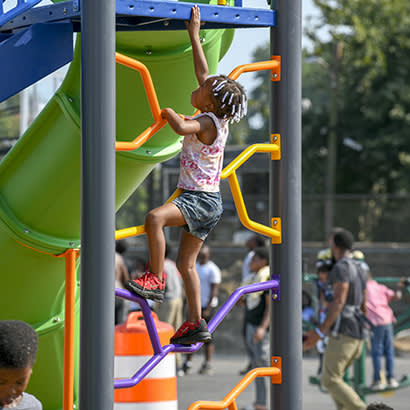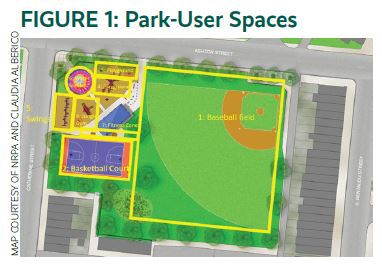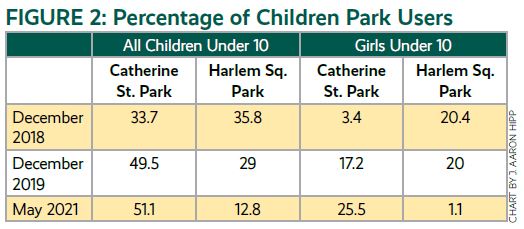
For an enhanced digital experience, read this story in the ezine.
Park and recreation experts provide new park-use data on Catherine Street Park more than two years after its Parks Build Community revitalization
The past two years have seen many changes within parks and recreation. Overall, use of our park and recreation resources appear to have increased, in some cases dramatically. But without proper and consistent evaluation, stories of our park use, and who is benefiting and where, are difficult to tell.
Catherine Street Park in Baltimore reopened with great fanfare to kick off the 2019 NRPA Annual Conference. The two-acre park received upgraded and expanded playground equipment, a splash pad, and swing sets, in addition to a new basketball court, outdoor fitness equipment, seating, and new fencing and signage. This Parks Build Community effort was different from previous ones, as it includes a five-year evaluation spanning from 2018 to 2023. The important decision was made in 2018, prior to the beginning of Catherine Street Park renovations, to include a comparison park. By evaluating Catherine Street Park and a nearby park with similar amenities and located in a neighborhood with similar demographics, we can be more confident that any changes in use and behaviors in and around Catherine Street Park are associated with the park improvements rather than other, external forces, such as a global pandemic. For instance, the coronavirus (COVID-19) pandemic and Baltimore City Recreation and Parks’ associated alerts, policies, closings and reopenings should impact both parks equally. With the parks located only one mile apart, the same is true for weather, public transit policy, bike and electric scooter share programs, and more.
Evaluation Methods
The timing of the evaluation effort has been both fortuitous and challenging. The investment in both a comparison park and five years of evaluation allow for better understanding of changes in park use at Catherine Street Park, as well as behaviors in the surrounding community — such as perceptions of safety, community support and access to the park. However, due to university research restrictions to minimize community and researcher exposure to COVID-19, in-person evaluation efforts were canceled during 2020. Again, deciding in 2018 to invest the resources in a long-term evaluation of the park minimizes the disruption that a one-year pause may cause in the evidence-based stories we are able to tell with our data evaluation. There always will be challenges to evaluation, including human and capital resources, but consistency in methods and measures can help overcome disruptions and challenges.
In addition to the decision to include a comparison park, it also was determined in 2018 to anchor the Parks Build Community evaluation on the use of systematic observations of the parks. The System for Observing Play and Recreation in Communities (SOPARC) has been used in park and recreation evaluation and research since 2006. Systematic observations, and specifically SOPARC, rely on trained evaluators (who can be researchers, students, community members, and park and recreation staff) to observe pre-determined park spaces intermittently and through brief scans. The scans of these park spaces are meant to be very brief snapshots of who is using the space and how, such as an adult female walking on a track or a 4-year-old boy playing on a slide. SOPARC also works by breaking up parks into distinct user spaces and observing, or scanning, each one every quarter hour (see Figure 1). An added benefit of using systematic observations during COVID-19 is the measure does not necessitate direct interactions with park users, further limiting any exposure, while providing the evaluation with detailed park-use data.

Due to the timing of the closure of Catherine Street Park for renovations, the pre-renovation systematic observations occurred during the first two weeks of December 2018. This effort was repeated in December 2019. December 2020 was missed due to COVID-19 travel and research restrictions, but systematic observations were able to continue in May 2021, and we have recently returned from observations the first two weeks of December 2021 (data and evaluation forthcoming).
Mid-Stream Findings
During the three years of systematic observations (December 2018, December 2019 and May 2021), we observed more than 1,000 people across approximately 50 hours spent in each park. Per park area scan, there was, on average, 1.8 park users at Catherine Street Park and one park user at Harlem Square Park. In setting up the systematic observations, we specifically tried to identify children under the age of 10 — those most likely to use the new playground equipment and swings. Overall, at Catherine Street Park, children were 48.6 percent of those observed using the park, compared to 27.2 percent at Harlem Square Park.
Looking at the yearly difference in Catherine Street Park, there were 0.4, 0.5 and 1.3 children per scan in December 2018, December 2019 and May 2021, respectively. By comparison, Harlem Square Park had averages of 0.6, 0.4 and 0.1 children per area across those same dates. Of note is the average number of children per scan at Catherine Street Park is increasing following the Parks Build Community renovation, and unsurprisingly, was highest in May 2021. The opposite is true for the comparison park, Harlem Square. We believe this may be due to Harlem Square Park being situated near a school and recreation center, both of which were mostly closed to in-person use due to the pandemic during the 2020/2021 school year.
Another way of looking at systematic observation data is to ask: What proportion of park users were children? In 2018, 33.7 percent of park users at Catherine Street Park were observed to be under the age of 10. In December 2019, post-Parks Build Community renovation, this was 49.5 percent. This means the proportion of park users observed to be children increased by 46.9 percent. In May 2021, more than 51 percent of observed users were children (see Figure 2). The opposite trend continued at the comparison park.
From here, we were curious about playground and swing-set space use specifically. Catherine Street Park improved from three distinct play areas prior to the Parks Build Community renovation to four areas after the renovation (see areas 3, 4, 5 and 8 in Figure 1). Looking at the average number of children per scan in these spaces, the difference in December 2018 and 2019 is 0.7 to 0.8, respectively. This may seem to be a small increase, but this is an average from more than 1,400 momentary scans, or observations, and does equate to a 14.3 percent increase in the number of children using the play spaces between pre- and post-Parks Build Community renovations. Again, the pandemic observations of May 2021 showed the greatest use with 2.1 children per scan of play spaces at Catherine Street Park, a three-fold increase from December 2018. During the same time, matched for weather and days of the week, Harlem Square Park experienced a 69.2 percent decrease in child use of play spaces.
As the SOPARC form allows the evaluator to specify the perceived gender of each park user, we are able to evaluate specifically if there was an increase in girls using Catherine Street Park after the renovation. Having previously studied kids’ use of parks, gender differences and safety, we thought there may indeed be a difference and were able to further look at girls’ (observed to be under 10 years of age) use of the two parks. We found a more than five-fold increase in the proportion of girls per play space between 2018 and 2019; from 3.4 percent to 17.2 percent of the total users observed in play spaces. In May 2021, the proportion of girls under 10 years of age increased to 25.5 percent of all users (see Figure 2). Harlem Square Park continued to see declines in overall child use of the park space between 2018 and 2021; girls were on average 20.4 percent, 20 percent and 1.1 percent of users of the park.

Analyzing the Findings
Having just returned from Baltimore and the December 2021 systematic observations, we believe the above findings will continue to be supported: that Catherine Street Park, post-Parks Build Community renovation, is supporting increased use by children, especially girls. A major focus of the renovations was upgraded and expanded playgrounds. The comparison playground at Harlem Square Park has not yet been upgraded and expanded. We believe the combination of new, colorful equipment and safer sightlines contributes directly to the increase in kids at Catherine Street Park. The previous design of Catherine Street Park placed the restroom facility between the single playground and the swing set. The renovation provides a more open and connected area for play with three distinct play structures, plus a swing set, all in front of the restroom facility. In addition, there is seating nearby and direct sightlines from the added fitness equipment and upgraded basketball court, another popular play area.
During the COVID-19 pandemic, there has been general increases in park use, but these increases have not been observed in every community. In fact, we found that under-resourced communities actually saw up to a 56 percent drop in park use during the first year of the pandemic. The evaluation numbers from Harlem Square Park seem to correspond with this drop, that even with the warmer weather of May 2021, there was a decrease in use compared to December 2018 and December 2019. However, Catherine Street Park, with recent investments and improvements in an otherwise under-resourced neighborhood, has bucked this trend and shown increases in use, especially among children. Though the timing of this evaluation has been challenging, the detailed measures are providing opportunities to highlight successes during the pandemic. Moving forward in 2022, we will continue systematic observations, as well as introduce qualitative interviews to provide context and stories to the changes in use of Catherine Street Park since 2018.
Thank you to our Parks Build Community Research Partner — BCI Burke Company, LLC — for their generous support, which has made this research possible.
J. Aaron Hipp, Ph.D., William Beam, Kat Deutsch and Christopher Dunstan are with the North Carolina State University Department of Parks, Recreation and Tourism Management and Center for Geospatial Analytics.

